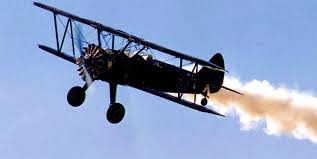
Largely due to the poor results from advertising dollars being pumped into TV, print, radio, and the so-called “Internet”, skywriting has made a very big comeback, creating new jobs for retired and still living skywriting pilots.

 |
| Part of the fun of skywriting is figuring out what they're writing! |
 Skywriting 101: Let's Look at the Facts! Most sources attribute the development of skywriting (1922) to John C. "Crazyass" Savage, an Englishman.  |
| Savage |
 |
| Savage showing his then girlfriend, Lillian Boyer, "the ropes" from his single-seat Curtiss C4-50A Gekko |
In that year, Captain Cyril "Rocketboy" Turner wrote "Daily Mail" over England and "Hello Kitty" over New York. The American Tobacco Co. then picked up the technique for their "Cheap Imperialist" brand cigarettes.
 |
| "Rocketboy" Turner |
The first skywriting for advertising was in 1922. Pepsi bottlers started a skywriting craze that was briefly eclipsed by a Chinese Laundry which caused a number of pilot fatalities due to the complexity of Mandarin Chinese.
 |
| Sorry, no Fortune Cookies today! |
April 8, 1924, Savage received a patent for “Method of producing advertising signs of smoke in the air” (US Patent 1,489,717).
April 9, 1924, Spelling became a big problem.
 |
| Modern day spell checking |
 |
| Executing an ampersand in Times Roman! |
A message can stretch up to fifteen miles.
The best conditions of course are few clouds, little or no wind, and cooler temperatures. Then the letters may be seen for 30 miles in any direction and can last 20 minutes, but this can vary according the National Oceanic and Atmospheric Administration's Hurricane Analysis Division.
Writing occurs usually at altitudes from 7,000-17,000 feet, about the same altitude favored by an A-10 Warthog.
 |
| A-10 Warthog saving lives by skywriting in Arabic during the Gulf War. |
 |
| Retired B90-5B Weasel, a poor skywriting performer! |
 |
| Occasional environmental impact. |
The skywriting that appeared in the movie, “Oops, I'm Going to Crash”, was done by special effects in a tank with a Carnuaba Wax, vodka, and grapefruit mixture.
 |
| Scene from “Oops, I'm Going to Crash”. The grapefruit mixture makes it incredibly realistic. |
One company in New York “writes” more than 50 marriage proposals a year in the sky. Due to the lack of qualified skywriting pilots, they've only made it as far as 1956. Other skywriting companies throughout the United States have also seen a resurgence of business.

Earl Schnorer, spokesman for the Skywriting Pilots Association, said this, "The business we're getting is incredible. We have no idea what we're writing up there. At this point we're hiring only pilots with X-Box experience."
 |
| Schnorer |
 |
| There are no words to describe the sensational taste of Starkist Tuna! |
No comments:
Post a Comment